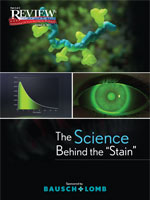The Science Behind the Stain
Read PDF Edition
It has been almost five years since I first published the article entitled “Much Ado About Staining” in Review of Optometry, which explored what we really knew in 2006 about the relationship between “corneal staining” and contact lens multipurpose solutions (MPS). This was published just prior to the controversial “staining grid.” While the Grid showed MPS-associated hyperfluorescence under the slit lamp at two hours, it did not explain the “what” or “why” behind it; even so, many proponents of the Grid continue to suggest that it shows us which solution/lens combinations are “biocompatible” and which are not. New evidence suggests that the preservative-associated transient hyperfluorescence (or PATH) observed at two hours after lens insertion is a benign phenomenon due to an interaction between fluorescein, MPS preservatives, and corneal cell membranes. The misinterpretation of PATH as “real” corneal staining, like that observed in pathological conditions, may be due in part to the fact that there is not a lot of teaching regarding the true properties of fluorescein and what is actually occurring when we see either PATH or corneal staining.
To discuss the science of fluorescein, corneal staining, and PATH, I have asked some of the preeminent research experts in the study of fluorescence spectroscopy and corneal staining from around the world to share their new research and personal opinions on these topics.
Additional Publications
-
Wellness Essentials for Clinical Practice - 4th Edition
In this special annual supplement, members of the Ocular Wellness & Nutrition Society (OWNS) contribute 10 articles on the intersection of physical wellness and eye health.
Supported by Bausch + Lomb
Two Torics, One Unmatched Design
A Breakthrough in Nutritional Supplementation for Dry Eyes
Annual Contact Lenses and Lens Care Guide - 2024
Practical Matters in Myopia Management - 2024
July Ophthalmic Product Guide


